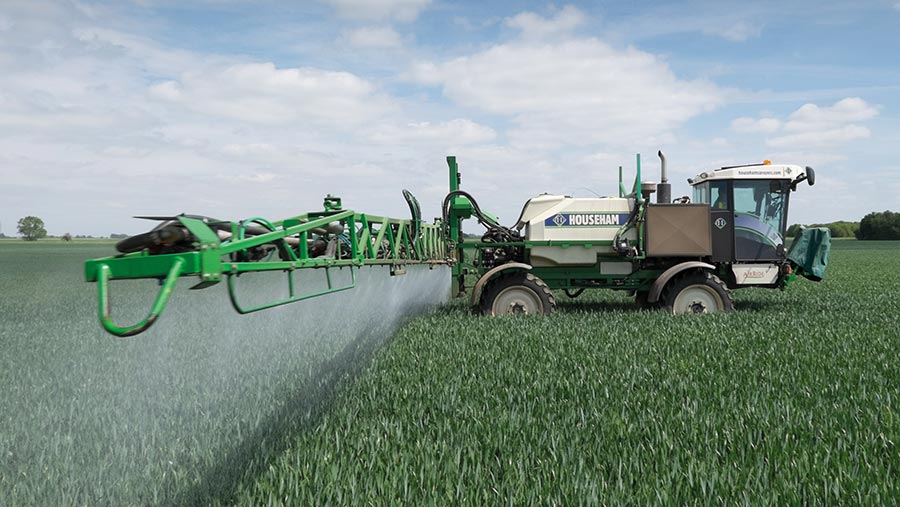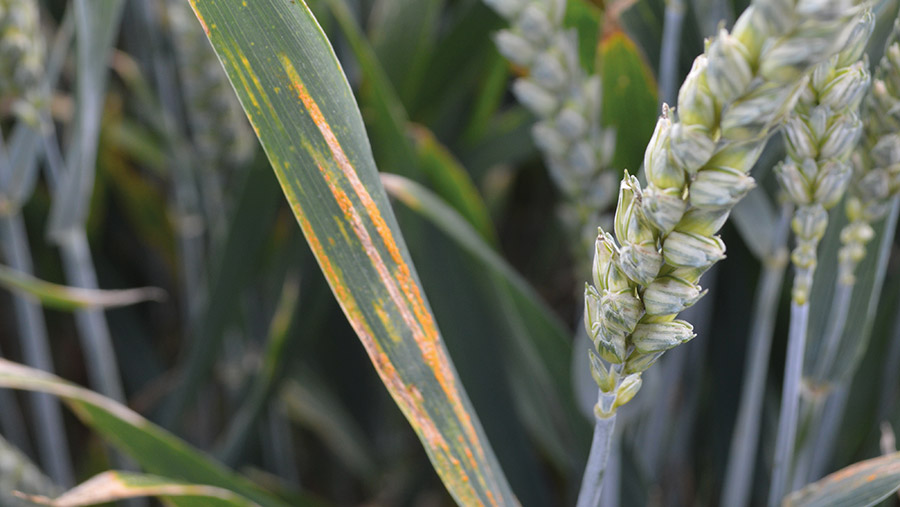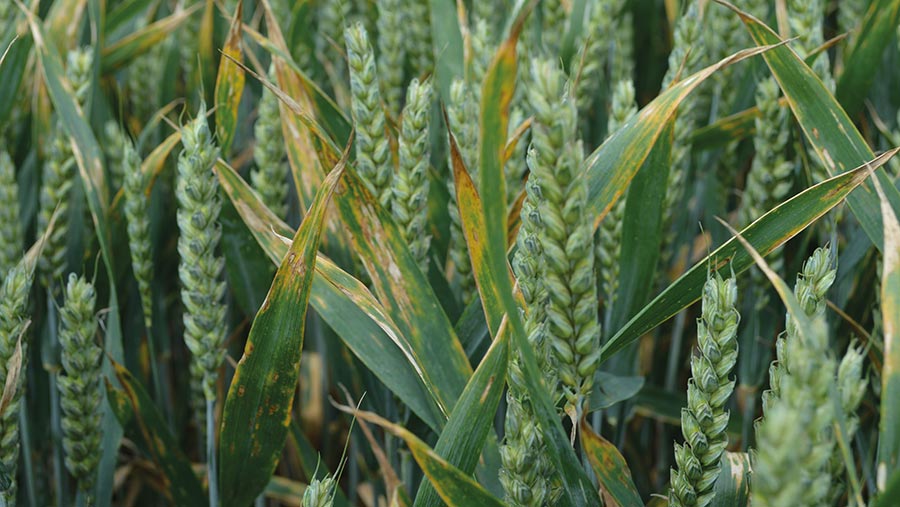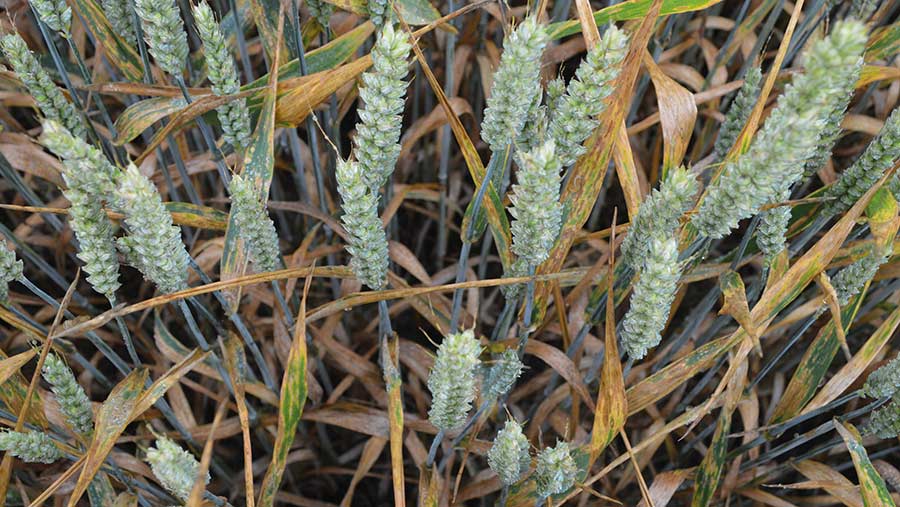Crop Doctor: Rain heightens wheat disease risk at T2 timing
 © Tim Scrivener
© Tim Scrivener Wheat growers are being urged to try out new chemistry for their all-important flag leaf fungicide sprays at the end of this month as yield responses from these novel products are more predictable than older actives.
In the second of a two-part series, we ask one independent disease expert and five agronomists across Britain about their strategies for T2 sprays, which are due to be applied towards the end of May.
Many wheat growers have reduced or cut out earlier T0 and T1 fungicide sprays altogether due to dry weather limiting disease, but the T2 flag leaf application has the biggest beneficial yield effect.
Bill Clark, technical director at crop consultant Niab, says warmer and wetter weather will bring yellow rust and septoria back into crops, so the newer fungicides may have to be used at T2 at robust rates.
“The fungicide variety story is evolving and there is a good case to use modern products, which are more predictable and give added benefits other than disease control,” he says.
See also: Robust T1 wheat fungicides likely after early savings
New chemistry at T2
Mr Clark suggests growers try out the new chemistry, such as Revystar and Univoq, at the T2 timing, although slightly older mixes such as Ascra and Elatus will still have a place.
Revystar is the SDHI-azole mix of fluxapyroxad + mefentrifluconazole launched last year, while newly available Univoq contains the fungicide fenpicoxamid – with a new site of action – plus the azole prothioconazole. Ascra and Elatus are SDHI-azole mixes.
The T2 flag leaf timing has consistently shown the biggest yield benefit over other fungicide applications, so this is when growers should be using the latest and most effective products.
“The cold April has checked yellow rust, but I fear that with a rise in temperatures, the disease could romp through crops,” says Mr Clark.
Yellow rust is very localised and growers should use the AHDB Recommended List resistance rating as a historic guide and treat what they see in the field, he adds.

© MAG/David Jones
Varietal resistance
Yellow rust-susceptible varieties Zyatt and Skyfall are showing the disease, but due to the variability in the race distribution, it has also been seen in more resistant varieties such as Extase.
Zyatt is rated 5 and Skyfall 3 for yellow rust resistance, while Extase is an 8, on a 1-9 scale where 1 is very susceptible and 9 shows good resistance.
Mr Clark is suggesting growers revert back to a more robust approach at the T2 flag leaf stage, as AHDB Recommended List trials using a hefty £200/ha fungicide spend showed a 1t/ha yield advantage compared with a more cautious £80/ha spend.
This showed there was a yield benefit even when there was no visible disease in the crop, so a robust approach at T2 is worthwhile, he says, especially given the high price of wheat, with feed wheat futures currently close to £190/t.
Key wheat fungicides
- Revystar SDHI fluxapyroxad (xemium) + azole mefentrifluconazole (revysol)
- Ascra SDHIs bixafen and fluopyram + azole prothioconazole
- Elatus Era SDHI benzovindiflupyr (solatenol) + azole prothioconazole
- Univoq Picolinamide fenpicoxamid (inatreq) + azole prothionconazole
- Folicur and other brands Tebuconazole
- Proline and other brands Prothioconazole
- Arizona and other brands Folpet
East
Andrew Melton says the risk of rain over the next few weeks should prompt wheat growers to look at a robust approach for their T2 flag leaf fungicide sprays.
Mr Melton, Frontier regional agronomy manager for Norfolk, Suffolk and Essex, says dry and cool weather has held disease levels back, but rain over the next few weeks will change all that.
“If we get some rain, all the data shows that the best return on investment is a robust T2 approach,” he says.
Many wheat growers are very mindful of input levels, but with high wheat prices there could be a big risk in cutting back too much on fungicides.
Mr Melton will be taking an SDHI/azole/strobilurin approach at T2, and is likely to include the multisite protectant fungicide folpet, with product rates dependent on variety, rotation and the yield potential of the crop.
Yellow rust is his main concern, but septoria is always around and with some light land growers in East Anglia irrigating wheat, this extra moisture will only encourage the wet-loving disease.
It will be a T2 approach based on variety, with the more disease-susceptible ones such as Barrel and new variety Wolverine watched carefully.

© MAG/David Jones
South
Rust is the main disease concern in the milling wheat areas of Kent and Essex, and Chris Bean says the use of fungicides to cope with yellow and brown rust this season will be key.
Mr Bean, technical director at agronomy group Zantra, says most quality wheat varieties are at risk – Skyfall and Zyatt to yellow rust, and Firefly to brown rust, with feed variety Spotlight the worst he has seen for yellow rust this season.
Skyfall and Zyatt have lowly yellow rust resistance scores of 3 and 5, while Firefly is rated 5 for brown rust, but most have reasonable resistance scores for septoria.
This season, he has looked to control rust inoculum at T0 and follow up using an SDHI-azole programme and folpet applied at T1, adjusting rates to the disease risk.
His T2 strategy is to take a robust approach, as septoria is ever present, yellow rust remains a concern and brown rust poses a big threat if the weather turns warmer.
His plan will likely be to use an SDHI/azole/strobilurin mix at T2, with the SDHI benzovindiflupyr chosen for its good action on rust, and a strobillurin added to boost control of brown rust, which can come into crops rapidly. “Most of the varieties here are Group 1 and 2 milling wheats, so the strobilurin could well also help with nitrogen uptake,” he says.
West
Agronomist Andrew Goodinson says recent rain may well heighten disease pressure, as septoria is present on the lower leaves of wheat crops, albeit currently at low levels.
A few early-sown wheats have septoria present, but most of the wheat crops in his area of Herefordshire, Worcestershire, Gloucestershire and just over the Welsh border were drilled late.
These late-drilled crop have less septoria, but there are low levels of yellow rust on varieties such as Skyfall, Spotlight and Graham.
Mr Goodinson, who works for agronomy group Hutchinsons, says septoria is his main concern in this western region, followed by yellow rust and then mildew.
His strategy has been to use tebuconazole at T0 to control any yellow rust, and give early-drilled crops an SDHI/azole/folpet mix at T1. For later-drilled crops, the SDHI has often been replaced by a strobulurin.
With T1 sprays being delayed due to the cool weather, this will narrow the gap between T1 and T2 sprays, as the T2 flag leaf stage tends to be fairly fixed.
“The shorter interval between T1 and T2 could allows us to reduce rates at the T2 stage on clean varieties such as Extase and Saki,” he says.
North
Sam Patchett is seeing septoria and yellow rust in his wheat crops across Yorkshire, and the agronomist says how seriously the diseases develop will depend on rainfall and warmth this month.
Many of his crops had an azole treatment at T0 to control yellow rust, especially on varieties such as Gleam, Skyfall and Graham and that made a big improvement on the health of these crops.
His T1 approach has been largely based on prothioconazole, with the bulk of crops also having an SDHI. A mildewicide is added if necessary, following cool and dry weather over the past three to four weeks.
Despite the cool weather, T1 sprays in his area have not been too delayed, with most going on in late April and during the first week of May.
His strategy for T2 will depend of the weather forecast, variety and drilling date, but he expects treatments to be based on an SDHI-azole approach for most crops.
“Cutting back on fungicides could be risky with the current high wheat prices,” says Mr Patchett, who works for agronomy firm Agrii.
The choice of SDHIs at T2 will depend on which disease is most prevalent, with benzovindiflupyr likely to be used where rust is the biggest risk, and fluxapyroxad where septoria is the biggest threat.
Scotland
Septoria is being seen at “normal” high levels in the north of Scotland, with the very popular variety Skyscraper showing disease on its lower leaves.
Alistair Gordon, who covers Easter Ross, the Black Isle and Morayshire, says recent weather has been cool, but there has been plenty of moisture to see septoria at high levels.
Mr Gordon, regional technical manager for Scotland at agronomy group ProCam, says in his area septoria is the number one wheat disease worry, followed by mildew. He rarely sees yellow rust.

© MAG/David Jones
His strategy for this season has been to use an early T0 spray based on prothioconazole and the multisite mancozeb to cope with septoria, and a T1 SDHI-azole approach, with mancozeb added.
For T2, he is likely to try new chemistry, saying that Revystar works well in cool conditions. He is also keen to try out Univoq.
Long-term protection is needed, especially with Skyscraper, which is popular with the distillers but has a lowish septoria resistance score of 5.1. The region’s number two variety, Jackal, scores only 4.8 for septoria resistance.
“Wheat crops up here often have a birthday, as crops drilled in mid-September are only harvested at the end of September, so fungicide persistence is important through the long summers,” he says.

